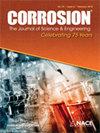热处理和构建方向对激光粉末床熔融快速成型合金 625 缝隙腐蚀敏感性的影响
IF 1.1
4区 材料科学
Q4 MATERIALS SCIENCE, MULTIDISCIPLINARY
引用次数: 0
摘要
本研究的目的是确定最佳热处理和构建方向,以最大限度地降低快速成型(AM)合金 625 对缝隙腐蚀的敏感性。为此,对两种不同构建方向的原样(NT)AM、去应力(SR)AM、固溶退火(SA)AM 和固溶加稳定退火(SSA)AM 合金 625 进行了金属对金属和丙烯酸对金属远程缝隙组装(RCA)实验。使用市售统计分析软件对金属对金属 RCA 实验的电流与时间数据进行了分析,该软件用于执行方差分析 (ANOVA)。虽然没有统计证据表明构建方向会影响缝隙腐蚀敏感性,但有确凿证据表明热处理会影响缝隙腐蚀敏感性。具体来说,根据 Tukey's 多元比较,与 NT 试样相比,经过热处理的合金的电荷通过率在统计学上明显较低。这一结果与测量的穿透深度一致,NT AM 试样的最大穿透深度最大。相反,丙烯酸-金属 RCA 用于计算缝隙腐蚀电流密度(速率)和再钝化电位。虽然 AM 材料的电流密度不相上下,但在 NT 和 SR 试样上,活动缝隙腐蚀前沿的横向移动速度相比之下较慢,导致局部损伤累积较高。金属对金属和丙烯酸对金属的 RCA 结果都是在与 AM 相关的非均质化微结构背景下进行讨论的。本文章由计算机程序翻译,如有差异,请以英文原文为准。
The Effect of Heat Treatment and Build Orientation on the Susceptibility of Laser Powder Bed Fusion Additively Manufactured Alloy 625 to Crevice Corrosion
The objective of this study was to determine the optimal heat treatment and build orientation to minimize the susceptibility of additively manufactured (AM) alloy 625 to crevice corrosion. To accomplish this, metal-to-metal and acrylic-to-metal remote crevice assembly (RCA) experiments were carried out for as made (NT) AM, stress relieved (SR) AM, solution annealed (SA) AM, and solution plus stabilization annealed (SSA) AM alloy 625 in two different build orientations. Current vs. time data from metal-to-metal RCA experiments were analyzed using a commercially available statistical analysis software that was used to perform Analysis of Variance (ANOVA). While there was a lack of statistical evidence build orientation has an effect on crevice corrosion susceptibility, there was strong evidence heat treatment affects crevice corrosion susceptibility. Specifically, according to Tukey’s Multiple Comparison, alloys that were heat treated had a statistically significant lower charge passed as compared to the NT specimens. This finding was consistent with measured penetration depth where NT AM specimens had the largest maximum penetration depth. In contrast, acrylic-to-metal RCAs were used to calculate crevice corrosion current density (rate) and repassivation potential. While current densities for the AM materials were comparable, the lateral motion of the active crevice corrosion front on the NT and SR specimens was found to be slow in comparison, resulting in high damage accumulation locally. Both metal-to-metal and acrylic-to-metal RCA results are discussed within the context of non-homogenized microstructures associated with AM.
求助全文
通过发布文献求助,成功后即可免费获取论文全文。
去求助
来源期刊

Corrosion
MATERIALS SCIENCE, MULTIDISCIPLINARY-METALLURGY & METALLURGICAL ENGINEERING
CiteScore
2.80
自引率
12.50%
发文量
97
审稿时长
3 months
期刊介绍:
CORROSION is the premier research journal featuring peer-reviewed technical articles from the world’s top researchers and provides a permanent record of progress in the science and technology of corrosion prevention and control. The scope of the journal includes the latest developments in areas of corrosion metallurgy, mechanisms, predictors, cracking (sulfide stress, stress corrosion, hydrogen-induced), passivation, and CO2 corrosion.
70+ years and over 7,100 peer-reviewed articles with advances in corrosion science and engineering have been published in CORROSION. The journal publishes seven article types – original articles, invited critical reviews, technical notes, corrosion communications fast-tracked for rapid publication, special research topic issues, research letters of yearly annual conference student poster sessions, and scientific investigations of field corrosion processes. CORROSION, the Journal of Science and Engineering, serves as an important communication platform for academics, researchers, technical libraries, and universities.
Articles considered for CORROSION should have significant permanent value and should accomplish at least one of the following objectives:
• Contribute awareness of corrosion phenomena,
• Advance understanding of fundamental process, and/or
• Further the knowledge of techniques and practices used to reduce corrosion.
 求助内容:
求助内容: 应助结果提醒方式:
应助结果提醒方式:


